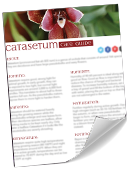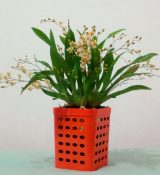Orchid Diseases Overview
Author: Melanie Dearringer16 Comments

Orchid Plant Family Diseases Information
Diseases are more than a nuisance to orchid plants, if left untreated they can kill them and/or spread to other healthy orchids. Treatment as soon as noticed is the best course of action.
The following is a summary of products that work on orchid diseases that other plant growers have used on their orchids with success. Indoor growers should treat their plants outdoors then bring back indoors after a few hours of airing out or wait until the next day if it’s practical (not recommended in winter). Everyone should buy liquids in smaller quantities to avoid degradation after opening, use liquid fungicides and anti-bacterials within 6 months after opening or buy a new batch.
Common Signs of Orchid Diseases
- Spotting on the Flower – A sign of fungal infection or mold is pink or light brown spots on the orchid flower. When you see either, be sure to check other plants as the infection can spread to other orchids if you are not careful. It is best to remove the orchid flowers that are affected. The remedy is usually to get more air circulation.
- Flowers with Punctures – Most likely not an orchid disease. Aphids and other orchid feeding insects can get damage your plants too. To get rid of insects on orchids just spray the plant with malathion, but be careful and use a face mask when applying it.
- Discolored or Bruised Leaves – The cause could be a color losing virus, but get a second opinion. Even if this is suspected then isolate the plant. If it is a virus then you need to destroy the plant. The causes of bruising are many. It could simply be from mechanical injury. If this is the case the area of damage will not increase or go on to other flowers. Slugs or even cockroaches are also a possibility of the cause. You may need to investigate and use some dust to bait them. If damage occurs from cockroaches then diazinon or Sevin on the ground and around the plant including the pot and base should keep them away. Bruising may also be from red aphid attacks. If so use a malathion treatment to get rid of the insects.
- Wilting of the Flower – If you notice wilting of the orchid flower, especially the dorsal or upper septal this can be caused by a sudden temperature change or pollination from an “unknown” pollinator. The remedies are those that make sense, moderate the temperature changes and remove any affected plants. If it happens to be an unknown attacker it will be harder to determine a remedy.
- Deformed Flowers – Common causes of deformed orchid flowers include low humidity or high temperatures when the buds were developing, mechanical or chemical injury during bud formation, the bud has acquired an unexplained deformity and potential infection by a virus.
Treatment of Orchid Diseases and Infections
- Insecticides – Never spray with the same insecticide twice in a row, alternate two or more to prevent the cause from developing a resistance to one. Insects, especially mealybugs, are some of the toughest to control. Drench at 7-10 day intervals with alternating insecticides 3 three times.
Insecticides for use on Orchid Plants
- Enstar & Precor – these are growth regulators that prevent insects from reaching maturity, breaking the life cycle. May be used with other insecticides, improving the chances of control.
- Diazinon – available in many concentrations, use at the rate recommended for roses, a contact spray, no systemic action. About $10 per quart. Also available as a microencapsulated form called Knox Out.
- Dursban – same as Diazinon, microencapsulated form is called Duraguard $10-16/qt-$40/qt.
- Orthene WP – a systemic in powder form, kinda stinky but effective, 2 tsp/gal.
- Liquid Sevin – same as Diazinon, keep off of exposed roots.
- Talstar – a wettable powder with systemic action, 1 tsp/gal. $65/lb.
- Gnatrol – a biological treatment for white fly and fungus gnats larvae, effective on grubs in mix only, drench mix to get to larvae, there is a residual action. Spray foliage with a contact spray or aerosol bomb to kill adults for full control. Gnatrol has a residual action against the larvae.
- Aerosol bombs – total release bombs for greenhouses only. Many aerosol bombs are available for greenhouse use. They treat up to 3000 sq feet per bomb. All internal fans should be running while in use to disperse the chemical and dry off the leaves. Good ones are Attain, X-Clude, Knox Out, Orthene, Preclude(growth regulator) and others.
- Attain – many insects and mites, see aerosol bombs.
- Fungicides – Never spray with the same fungicide twice in a row, alternate two or more to prevent the cause from developing a resistance to one.
Fungicides for use on Orchid Plants
- Cleary’s – available as a WP or liquid, a good broad spectrum systemic fungicide. About $40 -50 per quart/ bag.
- Captan or Sulfur – two old favorites, no systemic action. We use it to wipe directly on leaf and rhizome cuts when removing diseased tissue or dividing plants. Available in 8 oz containers for $6-8 or 5 lb bags for $17-20.
- Physan/Green Shield – any ammonia derivative that is good for removing algae, moss and has a fungal and antibacterial action. Use no more than once per month. Use at ½ TBS/gal for spraying plants, 1 TBS/gal for walls, benches and floors.
- Subdue/Resimyl – for root problems, may be used in conjunction with Cleary’s for total treatment of fungal problems. Subdue has been priced out of sight by changing it to a 1 drop/gal strength. Resimyl is the same chemical and is about $55/qt. Use 4-7 drops / gal.
- Strike/Bayleton – a powerful systemic that is to be used only as a last resort. Useful in controlling microfungus or unknown problems that seem unaffected by other fungicides.
- Terrachlor 75%WP – a good general fungicide for root problems during repotting or transplanting and drenching newly unflasked plants when planting into compots.
- Daconil – broad spectrum fungicide, no systemic action.
- Dithane M45 WP – a good broad spectrum fungicide, one of the only ones that will stop many rots in monopodals(Vandaceous) plants.
- Truban – another root rot type fungicide, use as a drench.
- Benlate/Benamyl – a systemic fungicide used on orchids for years, mixed 50/50 with Truban its called Banrot. In the late 1980’s the factory making Benlate DF did not adequately clean out its material handling system and some of the prior material being made at the plant was introduced into the batch of Benlate DF. Unfortunately the contaminant was a potent weed killer. Orchids and other plants died, lawsuits were filed and Benlate/Benamyl are no longer recommended for use on orchids. Use your own judgment.
- Anti-bacterials – Bacteria in orchids is probably the shortest route to death possible. An untreated plant can be dead in 2 days and the spores infecting others. A real problem in softer tissued plants. Cut out any dead or infected tissue and wipe with Kocide or Agri-Strep powder, blow or wipe off any extreme excess. Q-Tips or fingers are good for this. Prevention is the best cure.
Anti-bacterials for use on Orchid Plants
- Kocide – a copper compound that has an anti-fungal and anti-bacterial action, used mainly by Phal growers as a preventive for bacterial problems. Cheap $12-14 per 5 lb bag. Some people report problems if used on thin leaved orchids such as Miltonias, but I have never seen any problems. Do not used a spreader/sticker as some will interfere with the absorption of the copper, use a few drops of detergent. Keep away from the root zone. Use at ½ TBS per gallon as a foliar spray.
- Agri-Strep(Streptomycin) – a WP form of an anti-bacterial drug that my be used no more than 2x per year. More frequent use may cause a buildup of resistant strain of bacteria. About $8-10 per 2 oz or ½ lb bag.
This may seem like a lot of stuff to have on hand, but you will need to pick and choose sooner or later. Many are only available as multiple lifetime supplies for a bunch of dough. Split up those 5lb bags with friends or find someon who will sell a little that has been repackaged.
16 Responses to “Orchid Diseases Overview”
Leave a Reply


Ask an Expert
Questions about orchids?
Our experts love a challenge!
Photo of the Week
Submit your photo to be featured on the blog!
More Photo of the Week Winners
Submit Photo








I have a cymbidium and on the leaves there are oblong brown spots, sorta in the middle of the leaves. Would anyone have a guess on what is causing this. Is it some type of disease or insect etc.??
Hi all!
As a fresh http://www.orchidplantcare.info user i only want to say hello to everyone else who uses this forum 😀
Hello.
I’m new there
Nice forum!
Thank you!
I have an orchid with a white fuzz on the leaves. I can’t seem to find any information on how to treat it. Any suggesions?
White fuzz would be a the fruiting body of a fungus of some sort (ie a tiny mushroom). The first thing I’d try would be to wash the leaves off with lukewarm water real well. Also it may need to be repotted, if the media is old it starts to rot and can cause disease. I would try those first and then if all else fails go to your local garden center and ask for a fungicide, maybe one thats listed for orchids or tropicals.
The oblong brown spots are likely to be scale bugs. They are immobile at the adult stage and are drinking sap from your plant. It can be controlled with some diligence.
Hi my orchid has tiny white spots on the bulb bit, below the leaves and above the roots. But the leaves are fine. Do u know what it could have?
The flowers on my orchids have black spots that appear To be mold! What should i do?
Hi Cathy,
That sounds like Botrytris — a fungal disease. It is usually caused by not enough air circulation and too much moisture. You’ll want to remove any dead flowers or leaves that have fallen off, and if it seems to be spreading, you may even want to remove the flowers. Increasing the air circulation and reducing humidity will help your orchids to recover. Also try to water your orchids in the morning so they are dry by night. Orchids that are left with water on their leaves or flowers overnight have increased risk of fungal growth.
I have A vanda with the lower leaves turning yellow. is this water related? I usually decrease watering during the fall/winter.
Hi Joe, It’s entirely possible that if it’s only a bottom leaf or two, that it’s shedding older leaves as it continues to produce healthy leaves up top. Does the rest of the Vanda look healthy? No root rot, adequate watering/humidity, no pools of water sitting in the leaves at night, etc? If it otherwise looks healthy, I wouldn’t worry to much and just assume it’s taking it’s natural course of shedding old/growing new leaves.
Great web site you have here.. It’s hard to find excellent writing
like yours nowadays. I truly appreciate people like you! Take care!!
Is there a natural formula I can mix to rid orchids of bugs?
My orchids have sulfur residue on them from well water. How can I remove it?
One trick you can try is using a paper towel dipped in milk to wipe of the residue.